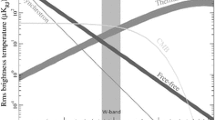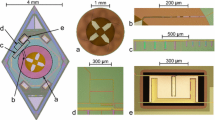Abstract
The lumped element kinetic inductance detectors (LEKID) demonstrated full maturity in the New IRAM KID Arrays (NIKA) instrument. These results allow directly comparing LEKID performance with other competing technologies (TES, doped silicon) in the mm and sub-mm range. A continuing effort is ongoing to improve the microfabrication technologies and concepts in order to satisfy the requirements of new instruments. More precisely, future satellites dedicated to cosmic microwave background (CMB) studies will require the same focal plane technology to cover, at least, the frequency range of 60–600 GHz. Aluminium LEKID developed for NIKA have so far demonstrated, under real telescope conditions, a performance approaching photon noise limitation in the band 120–300 GHz. By implementing superconducting bi-layers, we recently demonstrated LEKID arrays working in the range 80–120 GHz and with sensitivities approaching the goals for CMB missions. NIKA itself (350 pixels) is followed by a more ambitious project requiring several thousand (3000–5000) pixels. NIKA2 has been installed in October 2015 at the IRAM 30-m telescope. We will describe in detail the technological improvements that allowed a relatively harmless tenfold up-scaling in pixels count without degrading the initial sensitivity. In particular, we will briefly describe a solution to simplify the difficult fabrication step linked to the slot-line propagation mode in coplanar waveguide.






Similar content being viewed by others
References
A. Monfardini, A. Benoit, A. Bideaud et al., Astrophys. J. Suppl. 194, 24 (2011). doi:10.1088/0067-0049/194/2/24
A. Catalano, M. Calvo, N. Ponthieu et al., Astron. Astrophys. 569, A9 (2014). doi:10.1051/0004-6361/201526206
M. Calvo, et al., in The NIKA2 Instrument, a Dual-Band Kilopixel KID Array for Millimetric Astronomy. J. Low Temp. Phys., in this Special Issue
P.K. Day, H.G. LeDuc, B.A. Mazin, A. Vayonakis, J. Zmuidzinas, Nature 425, 817 (2003). doi:10.1038/nature02037
J. Zmuidzinas, Annu. Rev. Condens. Matter Phys. 3, 169 (2012). doi:10.1146/annurev-conmatphys-020911-125022
S. Doyle, J. Naylon, P. Mauskopf, et al., in Society of Photo-Optical Instrumentation Engineers (SPIE) Conference Series, vol. 7020. doi:10.1117/12.788941 (2008)
G. Coiffard, Ph.D. thesis, University of Grenoble (2015)
A. Adane, et al., in Cross-Coupling in a KID Array Caused by the Thickness Variation of Superconducting Metal. J. Low Temp. Phys., in this Special Issue. doi:10.1007/s10909-016-1490-3
A. Catalano, J. Goupy, H. Le Sueur et al., Astron. Astrophys. 580, A15 (2015). doi:10.1051/0004-6361/201526206
A.D. O’Connell, M. Ansmann, R.C. Bialczak, Appl. Phys. Lett. 92(11), 112903 (2008). doi:10.1063/1.2898887
Acknowledgments
This work has been performed at the “Plateforme Technologique Amont” (PTA) of Grenoble, with the financial support of the Labex “Focus”, the CNES and the ANR. We acknowledge the support of the cryogenics and electronics groups at the Institute NEEL.
Author information
Authors and Affiliations
Corresponding author
Rights and permissions
About this article
Cite this article
Goupy, J., Adane, A., Benoit, A. et al. Microfabrication Technology for Large Lekid Arrays: From Nika2 to Future Applications. J Low Temp Phys 184, 661–667 (2016). https://doi.org/10.1007/s10909-016-1531-y
Received:
Accepted:
Published:
Issue Date:
DOI: https://doi.org/10.1007/s10909-016-1531-y




